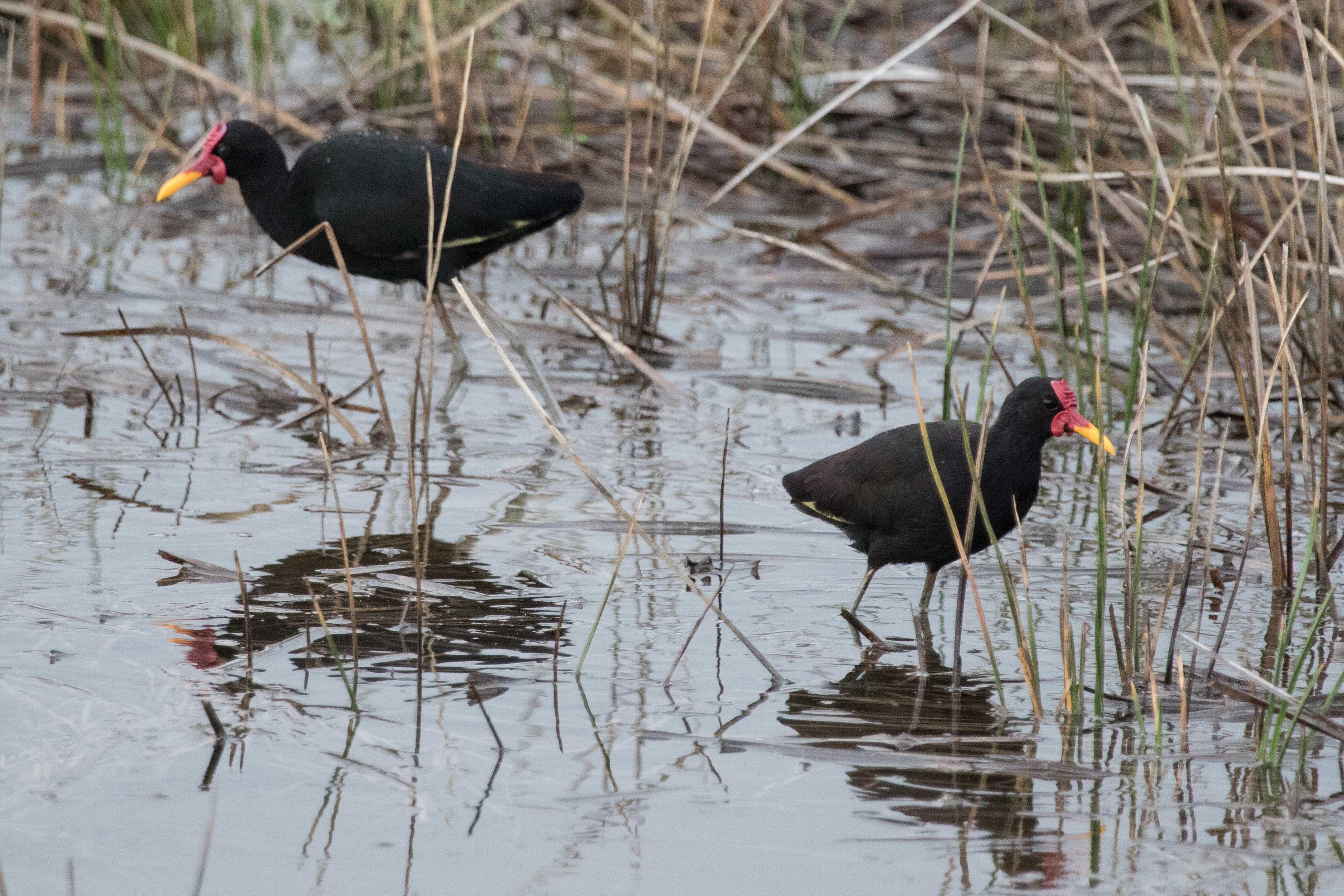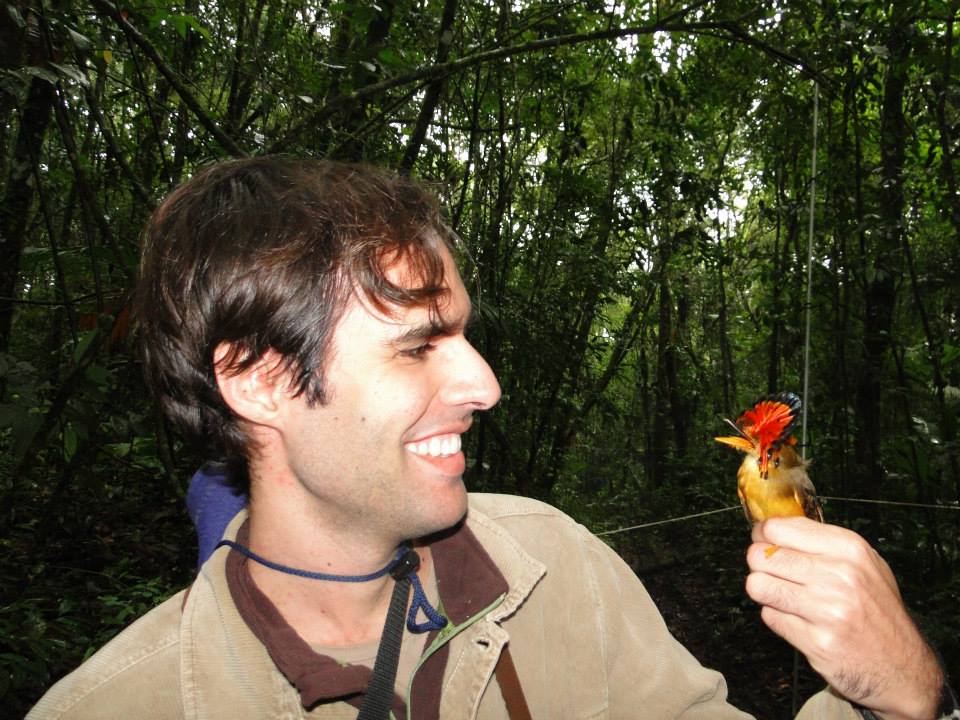Symposium: “How Female-Female Competition Affects Male-Male Competition: Insights into Postcopulatory Sexual Selection from Socially Polyandrous Species”
Posted on
by

Photo credit: Evan Buck
In his 1871 book The Descent of Man, Charles Darwin proposed the then-revolutionary theory of sexual selection, which explained extravagant traits that seemed disadvantageous if we considered only his earlier theory of natural selection. As Darwin saw it, females tend to be choosy when selecting sexual mates, whereas males tend to be less discriminating. This leads to intense male-male competition for females, which in turn selects for elaborate ornamental traits in males such as loud songs, bright colors, and energetic dances. But two major wrinkles in the mechanics of sexual selection escaped Darwin. First, sexual selection persists even after copulation: inside the female reproductive tract, sperm compete for access to the egg and females of many species can regulate that access, which may lead to selection for sperm traits such as speed and size. Additionally, sexual selection is not a one way street: not only do males compete for females, but also vice-versa. In fact, female competition can be stronger than male competition in some species, reaching a zenith in socially polyandrous species, where females mate with multiple males, have more developed secondary sexual traits, and forgo most or even all parental care, leaving it for the males instead. One example of this is the Northern Jacana, a wading bird from Central America and the Caribbean. Female Northern Jacanas can be up to twice as heavy as males, reversing the more typical pattern of difference in body mass between the sexes in birds.
Sara Lipshutz and collaborators used the Northern Jacana to look into the intersection of those two wrinkles missed by Darwin. They reasoned that because female jacanas may copulate with up to three different males within a span of 20 minutes, this might set the stage for very strong sperm competition. They compared the Northern Jacana to a closely related species, the Wattled Jacana, which has a lower degree of social polyandry, expecting male Northern Jacanas to have larger sperm and testes than male Wattled Jacanas. Braving the logistical challenges of the jacanas’ tropical and swampy habitats in Panama, Lipshutz and colleagues were able to collect testes and ejaculates from 18 male jacanas from the two species, preserve them, and bring them back to the lab for detailed study. Their findings support the main prediction: the two components of sperm most associated with swimming ability, the tail and the midpiece, are longer in Northern than in Wattled Jacanas.
Their work corroborates the hypothesis that intense competition between females for males leads to intense sperm competition and changes in sperm morphology. Thus, the behavior of one sex may cause changes in the physiology and morphology of the other sex. This study is particularly important because most of our knowledge of sperm competition in birds derives from species with “traditional” sex roles, such as the Zebra Finch and the Red-Winged Blackbird. Charles Darwin wore the blinders typical of his time and social position that prevented him from focusing on females and seeing sexual selection as a two-way process. Thankfully today, as science becomes more diverse and scientists become more aware of our own biases, our research emphases are expanding, allowing us to learn more about the diversity of evolutionary processes in their full glorious detail that we might have otherwise missed.
Abstract
Sexual selection is a major driver of trait variation, and the intensity of male competition for mating opportunities has been linked with sperm size across diverse taxa. Mating competition among females may also shape the evolution of sperm traits, but the effect of the interplay between female-female competition and male-male competition on sperm morphology is not well understood. We evaluated variation in sperm morphology in two species with socially polyandrous mating systems, in which females compete to mate with multiple males. Northern jacanas (Jacana spinosa) and wattled jacanas (J. jacana) vary in their degree of social polyandry and sexual dimorphism, suggesting species differences in the intensity of sexual selection. We compared mean and variance in sperm head, midpiece, and tail length between species and breeding stages because these measures have been associated with the intensity of sperm competition. We found that the species with greater polyandry, northern jacana, has sperm with longer midpieces and tails as well as marginally lower intraejaculate variation in tail length. Intraejaculate variation was also significantly lower in copulating males than in incubating males, suggesting flexibility in sperm production as males cycle between breeding stages. Our results indicate that stronger female-female competition for mating opportunities may also shape more intense male-male competition by selecting for longer and less variable sperm traits. These findings extend frameworks developed in socially monogamous species to reveal that sperm competition may be an important evolutionary force layered atop female-female competition for mates.
Cómo la competencia entre hembras afecta la competencia entre machos: perspectivas sobre la selección sexual poscopulatoria de especies socialmente poliándricas
La selección sexual es un promotor principal de la variación de caracteres y la intensidad de la competencia entre machos por acceder al apareamiento, ha sido relacionado con el tamaño del espermatozoide en distintos taxa. La competencia entre las hembras por una pareja también puede mediar en la evolución de los rasgos espermáticos, pero aún no se comprende bien el efecto de las interacciones competitivas de hembras-hembras y machos-machos en la morfología del esperma. Evaluamos la variación morfológica de los espermatozoides en dos sistemas de apareamiento socialmente poliándricos, en los que las hembras compiten por copular con distintos machos. La jacana norteña (Jacana spinosa) y la jacana carunculada (J. jacana) varían en sus niveles de poliandría y dimorfismo sexual, sugiriendo diferencias entre especies en la intensidad de la selección sexual. Comparamos las medias y varianzas en las longitudes de la cabeza, segmento intermedio y cola de los espermatozoides entre estas especies y sus etapas reproductivas, ya que estas medidas se han asociado con la intensidad competitiva de los espermatozoides. Hallamos que los espermatozoides de la especie con poliandría más intensa, la jacana norteña, poseen segmentos intermedios y colas más largos, así como una variación intra-eyacular marginalmente reducida en la longitud de la cola. La variación intra-eyacular también fue significativamente menor en machos copuladores con respecto a los incubadores, lo que sugiere una flexibilidad en la producción de esperma entre las etapas del ciclo reproductivo. Nuestros resultados indican que una competencia más intensa entre hembras por oportunidades de cópula también puede dar lugar a una competencia más intensa entre machos al seleccionar espermas con rasgos más largos y menos variables. Estos hallazgos amplían las nociones sobre la competencia espermática, desarrollados en especies socialmente monógamas, para revelar que la competencia espermática puede ser una fuerza evolutiva importante superpuesta a la competencia entre hembras por parejas.

Photo credit: Evan Buck
Author Bio:
Dr. Rafael Marcondes is an ornithologist and evolutionary biologist. His research centers on using birds as models to answer fundamental questions in evolutionary biology, especially related to phenotypic diversification. He received his Ph.D. from Louisiana State University and is currently a faculty-fellow at Rice University.